Research in the time of covid
Maria Zuber got the word on a Friday: Harvard had shut down its research labs. As vice president for research, Zuber consulted with lead researchers across campus over whether MIT should follow suit. Don't you dare," she remembers them saying. Don't you dare be like those Harvard people."
As covid-19 cases continued to rise across the country, however, she and other senior administrators made the difficult decision by that Sunday: MIT would be scaling down its research to near zero for the first time since opening its doors 155 years ago. It was a complete shock to people," Zuber says. We gave labs three days to come up with a plan, and another three days to execute it."
MIT has always prided itself on being always open. Professors go into the lab at 3 a.m. to check on experiments and find that grad students may be just putting on another pot of coffee. Closing just isn't in the Institute's DNA. We view ourselves as a 24/7 institution," says Zuber, who is also the E. A. Griswold Professor of Geophysics.
Since that Friday the 13th in March, however, MIT has had to adjust to research in the time of covid. With more than 90% of its labs shut down by March 20, researchers have had to adapt to working from home and collaborating over Zoom. Meanwhile, faculty tapped to serve on the Research Ramp-Up Lightning Committee began collaborating in mid-April to solve a daunting engineering challenge: how to open up MIT's research labs safely once more.
Ramp downKrystyn Van Vliet, a professor of biological engineering and materials science, was on a plane home from Singapore just days after the first three covid cases were identified there. She knew the outbreak would soon be hitting the US. By the time she got back to Cambridge, Van Vliet had started preparations, drafting plans to divide her team into three units that would work different shifts so if any one person contracted the virus, others would be protected.
Then, less than two months later, came the order to shut down her lab entirely. At the time of the announcement, she was working on a line of stem cells that take 80 days to grow. We had to close down that experiment and lose three months of work," Van Vliet says. Her team frantically gathered whatever data they could before they had to dispose of the cells. You have to manage the disappointment," she says.
Closing just isn't in the Institute's DNA. We view ourselves as a 24/7 institution," says geophysics professor Maria Zuber, MIT's vice president for research.
As MIT's associate provost, Van Vliet had the additional responsibility of managing the use of lab space on campus during the pandemic, leading nightly meetings of the Space Contingency Working Group. MIT ramped down, but it never completely closed," she says. Exemptions were given to labs studying the coronavirus, working on such things as developing and testing a new vaccine or designing a new ventilator.
In addition, researchers could apply for exemptions to work on ongoing experiments involving expensive materials or rare animals, such as a specialized strain of transgenic mice. Koch Institute director Tyler Jacks, a professor of biology, was about four months into experiments testing a new drug for efficacy against certain types of cancer. Animals had been dosed multiple times, but the research wouldn't be completed for another month or two," he says. To terminate abruptly would result in the irrevocable loss of data, materials, and frankly resources." In the end, about 10% of labs, including his, stayed active.
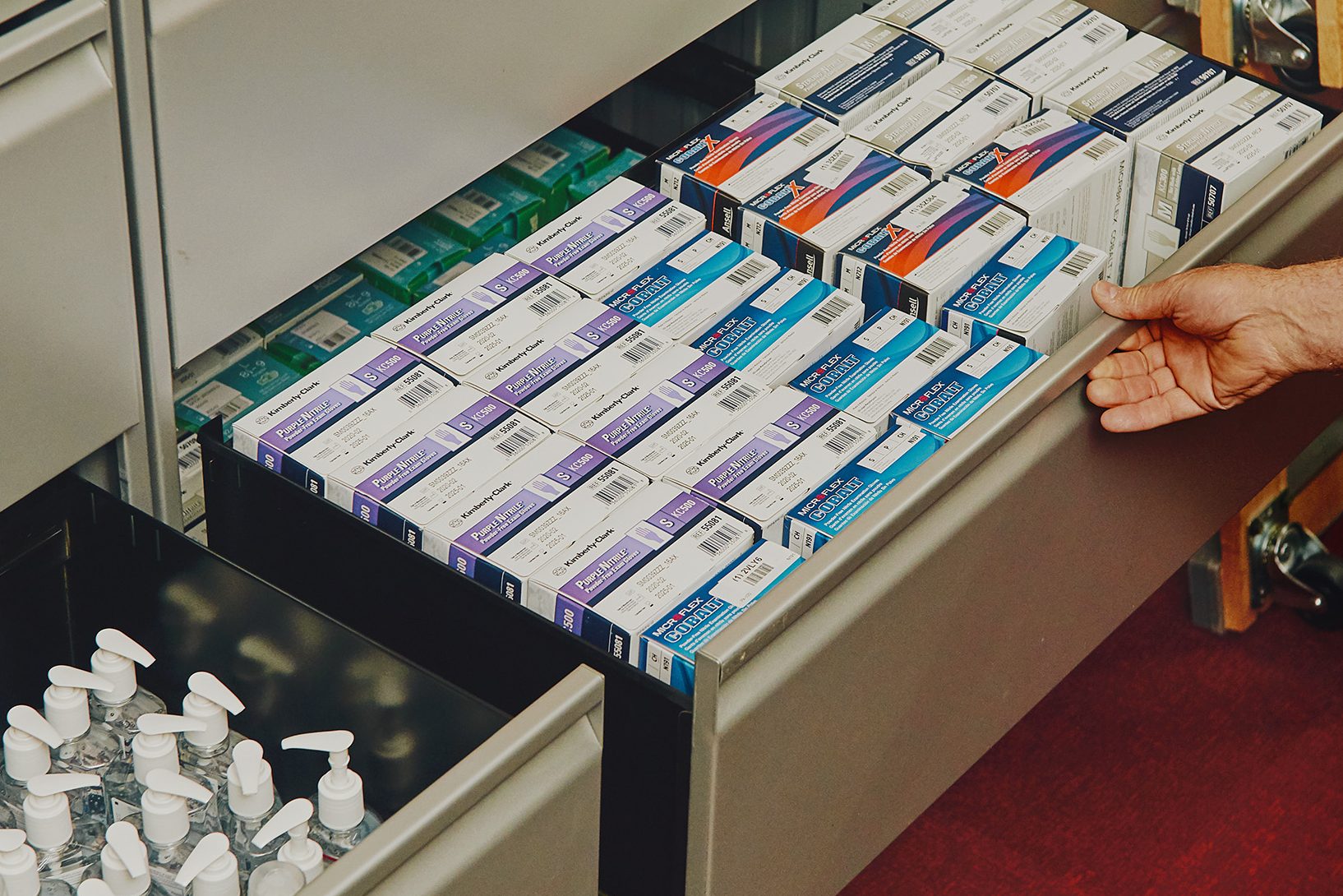 Drawers at CSAIL that once held cables are now stocked with gloves, masks, and hand sanitizer.TONY LUONG
Drawers at CSAIL that once held cables are now stocked with gloves, masks, and hand sanitizer.TONY LUONGEveryone else, however, was forced to shut down as quickly and completely as possible. Canan Dagdeviren, an assistant professor at the MIT Media Lab who designs conformable electronic devices for biomedical applications, counted herself lucky. As a junior faculty member facing space and budget constraints, she had set up her space from the start as an efficient lean lab." Color-coded maps in her clean room and cloud storage of data allowed her to shut down quickly. We have standard operating procedures for emergencies, and everyone knew what to do," Dagdeviren says. They took it all apart from start to end in 15 minutes."
For researchers working on complicated biological or animal experiments, turning on a dime to shift to a virtual lab wasn't so easy. Neuroscience professor Jim DiCarlo, head of the Brain and Cognitive Sciences Department, does both computational modeling and behavioral experiments involving primates. Our experiments with animals had to basically stop-it's painful from a research perspective," he says. Some types of research, for example, involve implanting electrodes into the brains of the primates and must be monitored closely for six months. While none of those experiments were then under way, the closure meant any new experiments had to be put on hold. We couldn't perform them from an ethical perspective unless we knew they were going to continue the entire time," he says.
Someone, of course, also had to keep caring for the animals. The job of making sure that happened fell to Jim Fox, professor of biological engineering and director of the Division of Comparative Medicine, which oversees more than 100,000 animals-including mice and rats, zebrafish and zebra finches, pigs and primates. Some rodents were euthanized, but other mice and rats and all other animals remained on campus, spread out over seven buildings, throughout the closure. Primates are in a special category because of cost and availability and ethical issues," he says. Others are specially genetically engineered animals that are very difficult to replace."
While there was concern that some primates could contract the coronavirus, their animal technicians were already wearing full protective gear-surgical masks, face shields, lab coats, gloves-to stop transmission of any pathogens. For those caring for other animals, Fox mandated the use of masks as well as the usual gloves and lab coats, stepping up sanitation procedures too.
None of the animals contracted covid during the three-month lockdown, but three technicians did. Fortunately, they stayed home and were retested, and all came back to work without a problem," Fox says.
LockdownHaving shut down their campus operations, most researchers across MIT had to shift their work to a virtual environment. Many, like DiCarlo, were still able to be productive remotely. We've got plenty of data, and took advantage of the time to get it better organized and analyzed," he says. The silver lining of this is that we can catch up on all of the things we usually don't have time to do." In the time away from the lab, he says, his team was able to make headway on long-standing goals of sharing data more publicly and developing a platform for benchmarking computational models against experimental data.
Still, the three-month closure was difficult for grad students dependent upon their research for an advanced degree.
I was in the middle of an experiment involving several monkeys, and starting to get some really good data, as coronavirus started to break out," says Michael Lee, a grad student in DiCarlo's lab who conducts behavioral experiments with primates to study visual computation and learning. It was a little disappointing not being able to continue."
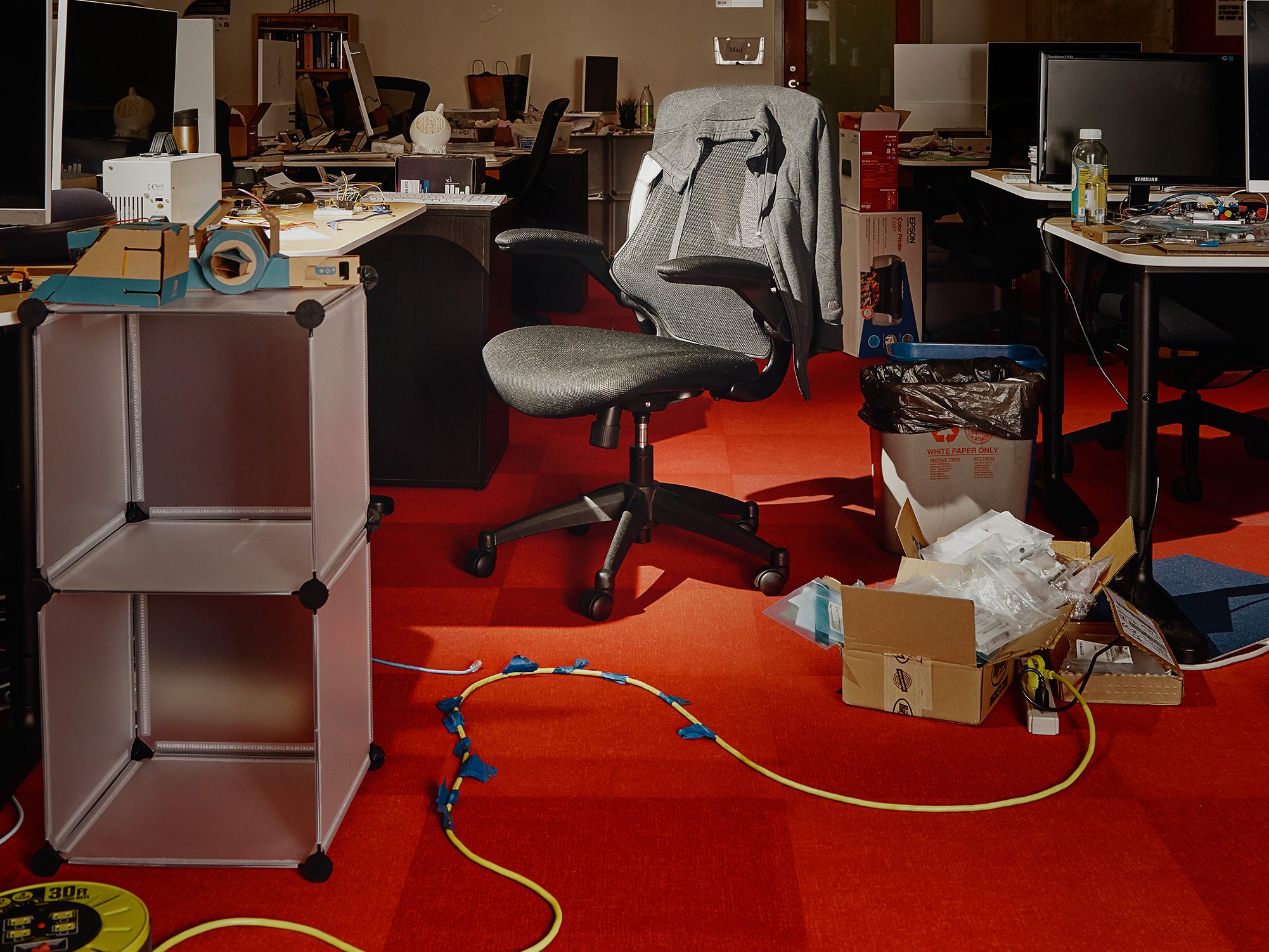 With strict social distancing rules in place, a researcher's jacket marks the only chair in use in a CSAIL lab on a Tuesday in September.TONY LUONG
With strict social distancing rules in place, a researcher's jacket marks the only chair in use in a CSAIL lab on a Tuesday in September.TONY LUONGAlthough he wasn't completely stuck, since some of his work involves coding and analysis he could perform remotely, it was nerve-wracking to pause his research. Like many graduate students, I feel pressure to always be striving toward graduation, so there was some feeling of anxiety about how long my experiments would be on hold," Lee says.
Other researchers had to figure out new ways to continue their work virtually. As a junior faculty member, I don't have the luxury to stop or slow down," says Dagdeviren, so I said to my students, We can't go inside the clean room physically, so why don't we do experiments in simulations?'"
She reached out to theoretical physicists at the University of Buffalo, who collaborated on simulations for the materials they were studying in the lab. Now our students are not only experimentalists," she says, but they are starting to be theorists as well."
For researchers at the Computer Science and Artificial Intelligence Laboratory (CSAIL), staying out of the lab posed other challenges. There are some students and researchers who need access to special equipment like robots and 3D printers," says CSAIL director Daniela Rus. Some were able to send files to a fabrication company to print designs, while others bought their own desktop 3D printers. We've been able to fabricate in our homes, but not as extensively and not with as wide a range of materials as in the lab," she says.
Her team, however, has also used the time away from the lab to develop new simulations. For a project involving new control systems for autonomous driving, the researchers were able to work with an existing data set to simulate various driving conditions, such as different lighting or weather. All of these things are actually quite difficult to implement in simulation, but we have made a great deal of progress and are very excited about getting more capable in training a [machine-learning model] starting with one data set," Rus says.
Of course, researchers also had to deal with new communication techniques for a world in which they couldn't just scribble equations and formulas on the nearest whiteboard. Even though the work can be done online, the thinking is often done in person," says Van Vliet, whose lab already had some experience using online tools to share screens with colleagues in Singapore.
Adjusting to a covid world, in which many researchers were juggling their work with other issues like caring for children at home, meant having to plan much of that formerly spontaneous conversation in advance. We had to use Slack or a group calendar to say We're going to get together and talk about this'-not just leave it to email or chance," she says.
Ramp upHow do you manage access to MIT's buildings in a campus that's been historically open?" asks Joe Higgins, vice president for campus services and stewardship. It isn't a rhetorical question. There are some doors on campus that have never had locks on them," he says.
But if researchers were ever going to return to campus, then controlling access to the buildings would be critical to keeping them safe. Tackling that was one of many issues on the agenda for the group of faculty researchers and administrators Zuber appointed to the Lightning Committee, so named because they were charged with swiftly proposing guidelines for safely reopening MIT's research labs.
How do you manage access to MIT's buildings in a campus that's been historically open? There are some doors on campus that have never had locks on them."
We had to work at lightning speed," says Jacks, who chairs the committee. Other members include heads of the biggest departments, labs, and centers on campus, including DiCarlo and Rus. These are people who are used to not only doing research but also planning and overseeing research activities," Jacks says. We could get input from other faculty and disseminate information so the guidelines came from the ranks, if you will. I think for MIT at least, it was a more appropriate strategy than having them come from above and be imposed on all the labs."
Together, Zuber, the committee, and Van Vliet and the MIT Space Contingency Working Group ultimately decided on 42 exterior doors that would allow access into the buildings-with other entryways locked for the foreseeable future.
Once inside, researchers would be expected to head straight to their labs, avoiding the usual serendipitous encounters in the Infinite Corridor that often spark collaborations. To limit opportunities for the coronavirus to spread, Van Vliet's Space Contingency Working Group divided the campus buildings, many of which are interconnected, into 13 clusters, and essentially cut them off from each other.
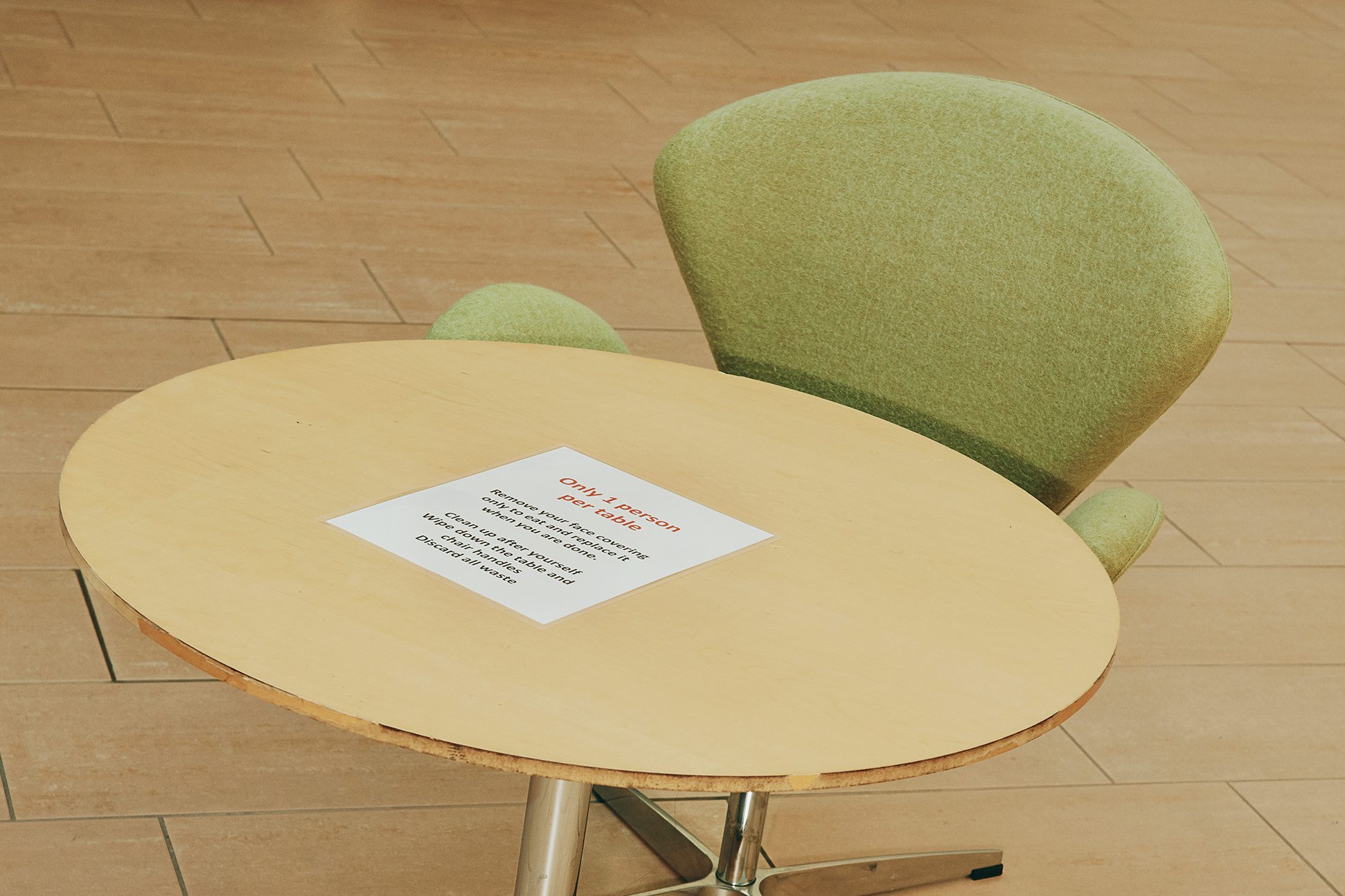 In the atrium of Building 46,a sign reminds Brain and Cognitive Sciences researchers of the one-person-per-table limit.TONY LUONG
In the atrium of Building 46,a sign reminds Brain and Cognitive Sciences researchers of the one-person-per-table limit.TONY LUONGWe had to create artificial neighborhoods," says Van Vliet. We'd say, Your lab is in Cluster 1, and you guys are going to go in and out of this door, and this door only.'" (Of course, it wasn't practical to block off the many connections of the Infinite Corridor itself. This is an honor system," Higgins says.)
Unlike many universities, however, MIT had used key cards to control access only to certain buildings; others were never locked. So a pilot program was set up for three buildings housing most of the work that continued on campus during the lockdown: Buildings 76 (the Koch Institute), 68 (Biology), and E17-E25, which houses many administrative and academic groups, including the Institute for Medical Engineering and Science. People were given access to particular buildings, tapping their IDs at temporary card readers to get in. Greeters also staffed check-in desks to confirm that those entering were on the approved access list, and to provide face coverings if needed.
It very quickly became clear that such a system was not scalable to the entire campus, so the Information Systems & Technology (IS&T) team began to look into access control applications, using hospitals as a model. The IS&T engineers then designed Covid Access, a system tying identifying information for each person requesting campus access to the results of a covid test. Everyone coming to campus must get tested regularly (as often as twice a week), and attest to being symptom-free each morning through the Covid Pass app, which feeds into the Covid Access system.
We had this eureka moment, where instead of having people claim they were healthy at a station, we could link that to an access card that wouldn't work without it," Higgins says. IS&T had to program researchers' MIT IDs to serve as keys that would allow access only to their particular building clusters, a process that required some tweaking. They also provided key-card access to specific buildings for vendors and contractors, including those servicing labs and lab equipment.
To ensure proper social distancing, Massachusetts had set guidelines of eight people per 1,000 square feet of space, or 125 square feet per person. The Lightning Committee recommended that MIT start with 160 square feet per person, which would leave lab capacity at approximately 25% of pre-covid numbers. The question was how to get labs to adhere to the requirements. Everybody at MIT wants to know what the rules are so they can break them," Higgins jokes.
Early on, they considered giving principal investigators the option of getting to 25% lab density by thinking about it in terms of hours worked or lab space. We said, let's gamify it and give them space and time, and they can solve for either equation," Higgins says. In the end, they had PIs calculate the maximum number of researchers who could be in their lab at once, given the 160-square-feet rule, and divvy up the available hours as they saw fit.
As both an administrator and a researcher, Van Vliet appreciated being able to schedule her team's work this way: It gave me flexibility as a PI to say, okay, I have a bundle of hours-how can I schedule them? Like I was scheduling shifts of staff of a diner." In addition, if a particular lab needed more hours in a particular week, it could trade with a neighboring lab for hours in the following week.
The Lightning Committee worked through countless such issues, collaborating closely not only with IS&T, Higgins and the Campus Operations team, and Van Vliet and the Space Contingency Working Group, but also with such groups as MIT Medical, the Environmental Health and Safety group, the procurement team, and MIT Emergency Management.
Keeping everyone safe meant requiring everyone in the buildings to wear masks at all times-except when they were eating or drinking, or alone in a closed-door office. So the team that had collected personal protective equipment from the Institute's labs to donate to frontline health-care workers in the early days of the pandemic shifted its focus to preparing for the repopulation of campus. They called upon alumni and research networks in Asia and South America, where equipment is manufactured, to help restock PPE. And since the usual decentralized approach to ordering supplies wouldn't work in a pandemic, they also worked with MIT's procurement team to set up the MIT Covid-19 Store, which delivers free PPE in a day or two to any department requesting it.
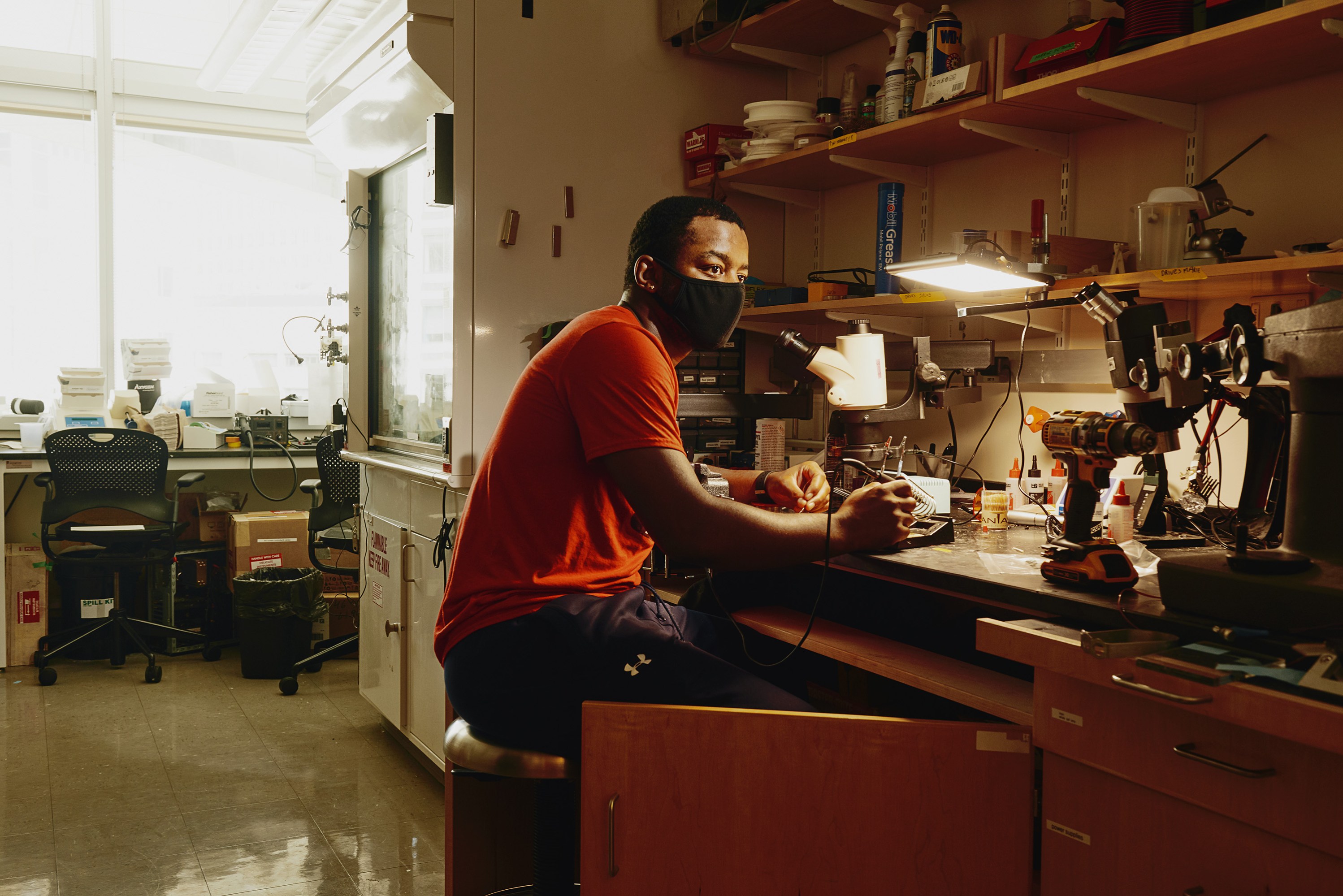 Researcher Nicholas Miller has a section of Mark Harnett's lab to himself at the McGovern Institute for Brain Research.TONY LUONG
Researcher Nicholas Miller has a section of Mark Harnett's lab to himself at the McGovern Institute for Brain Research.TONY LUONGMeanwhile, a faculty team on campus and researchers at Lincoln Laboratory's Humanitarian Assistance and Disaster Relief Systems Group began developing the MIT Covid-19 Response System (better known as MCRS), which includes a dashboard to help MIT's medical and operational leaders understand infection risk on campus. Integrating de-identified data from multiple sources-such as Covid Access, daily records of campus badge readers, and PIs' floor plans for the research ramp-up-the system models building density and traffic patterns and will eventually incorporate predictive analytics. An initial version launched in September.
As Zuber and the Lightning Committee prepared to open laboratories again in early June, a shortage of disinfectant wipes forced a one-week delay. We got all the key cards changed and the app written, and everything worked perfectly," says Zuber, and then the wipes didn't arrive." But on June 15, after the team had sourced a reliable supply of spray disinfectants, MIT's labs officially ramped up to 25% capacity again. With many researchers leery of using public transportation, the MIT leadership team made parking free on campus. It was just about being realistic and doing a little to reduce people's anxiety," he says.
A new normalThe measures put in place appear to have paid off-between mid-June and mid-August, just four cases of covid were detected on campus. After a month of 25% density, the Lightning Committee allowed labs to increase capacity to 50% of their previous person-hours, decreasing the required space per researcher to 125 square feet. (An anticipated third phase this fall would in theory open labs up to 100% capacity, though researchers will still be encouraged to do whatever work they can at home.)
To accommodate more researchers on campus and the arrival of seniors for the fall term, MIT Medical ramped up its testing capability significantly in mid-August. Of the more than 22,000 tests given to those seeking campus access between August 17 and 31, just 10 (or 0.05%) were positive, resulting in prompt quarantining and the usual protocol of contact tracing.
In ramping up, labs have had to make adjustments for a research environment in which members are required to wear masks and stay six feet apart. People are much more careful about how they allocate their time," says Rus. Their time on campus is much more intentional-they come in to make a surgical strike to use the 3D printers or run a robot experiment that was tested in simulation."
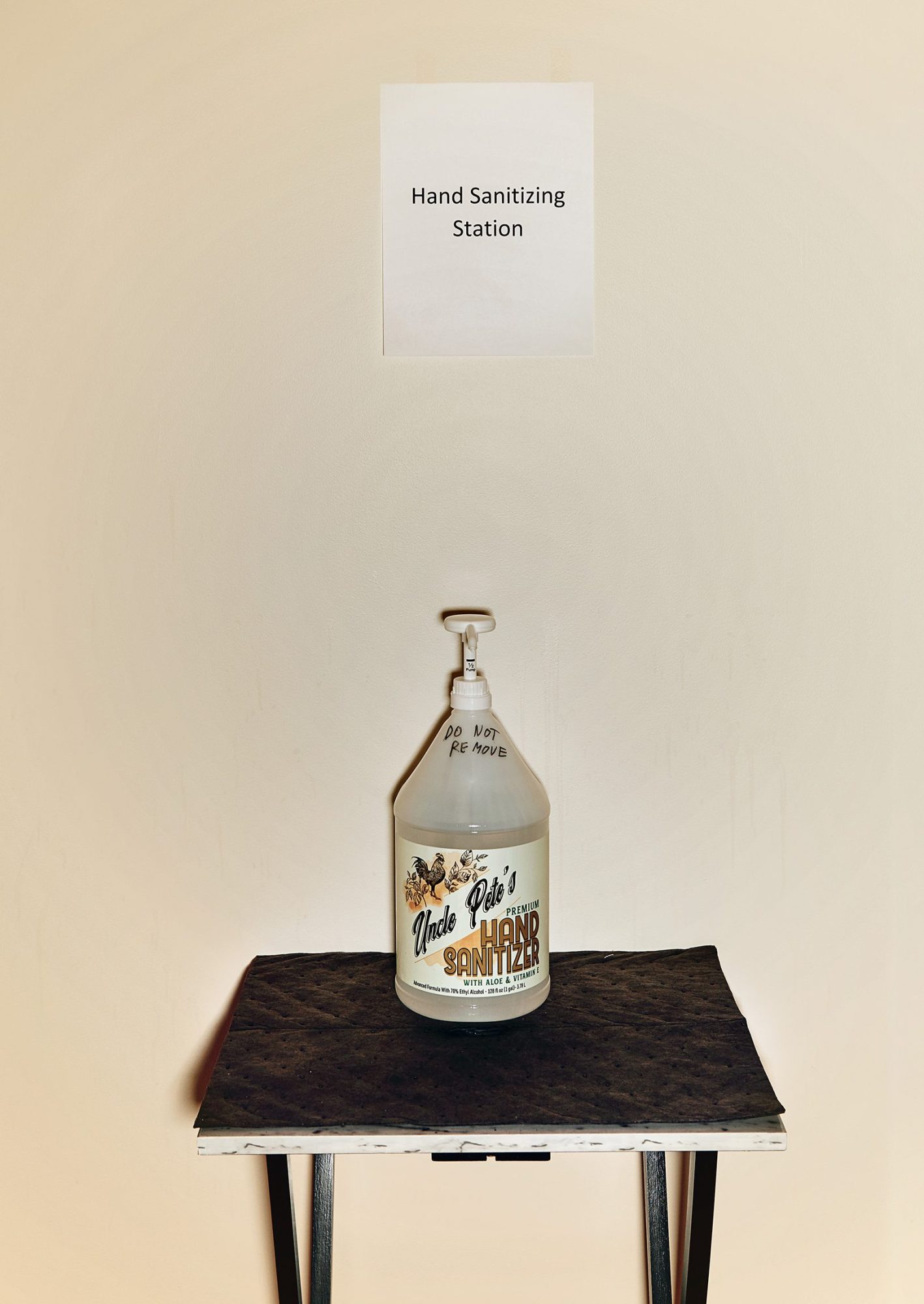 A hand sanitizing station in Building 46.
A hand sanitizing station in Building 46.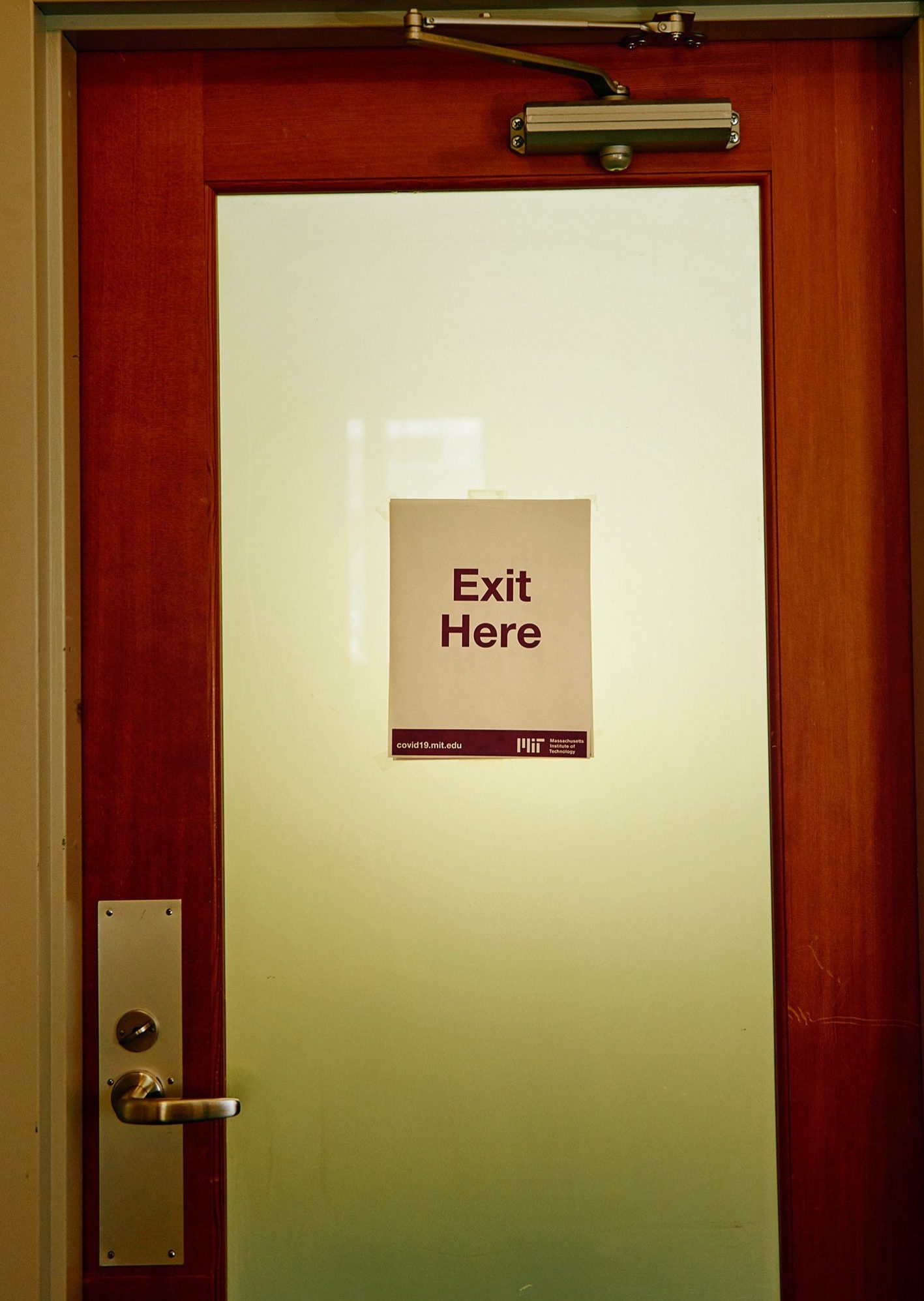 Some corridors are designated for one-way traffics, as this CSAIL door sign indicates.
Some corridors are designated for one-way traffics, as this CSAIL door sign indicates.DiCarlo agrees. It's sort of come in, get the data, get out," he says. In former days, a part of his space in Building 46 was the wet lab" where researchers suited up with masks and gloves to perform experiments, while the rest was dry space" where they could have a cup of coffee and socialize. Now it's like the entire building is a wet lab," he says. You may see a few people walking by wearing masks, but otherwise it's pretty quiet."
When Lee started to work again with his monkeys, he says, I was amazed at how shiny the floors were." He was able to pick right back up with the experiments. Luckily, my monkeys still knew how to do the behavioral tasks I had given them," he says. Still, he misses the camaraderie and long conversations with lab mates. I do miss being with my lab friends and colleagues," he says. It's pretty lonely."
Researchers have had to make numerous adjustments. Van Vliet says she can no longer work side by side with students even though you need to be looking into the same microscope to help them." Her team has taken to wearing head-mounted GoPro cameras while working under the hood, so that colleagues can watch virtually on a screen. The cell types we work with are precious-we have to work with them just right," Van Vliet says. Our brains are getting rewired as we go."
For all the inconveniences and difficulties, the experience has not been without its serendipitous benefits-in new virtual ways of working, enhanced simulations for experiments, or different perspectives on how the research will ultimately be used.
We never would have done an experiment in which we told people to work at home for long periods of time," says Zuber. In any good research, however, sometimes the biggest discoveries come from the results you never expected. People have shown themselves to be incredibly productive and worked really effectively at home," she says. I think there is going to be a lot more flexibility in the future in how people work."